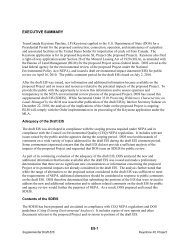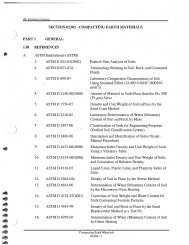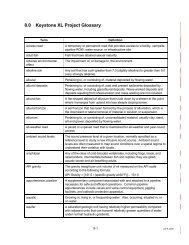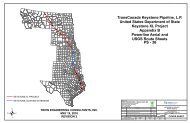2.1 Overview of the Proposed Project - Keystone XL pipeline - US ...
2.1 Overview of the Proposed Project - Keystone XL pipeline - US ...
2.1 Overview of the Proposed Project - Keystone XL pipeline - US ...
Create successful ePaper yourself
Turn your PDF publications into a flip-book with our unique Google optimized e-Paper software.
Draft Supplemental Environmental Impact Statement<strong>Keystone</strong> <strong>XL</strong> <strong>Project</strong>The HDD method could also be used to bore beneath terrestrial areas that contain specialresources that require avoidance. Additional HDD crossings could be incorporated into <strong>the</strong>proposed <strong>Project</strong> as a result <strong>of</strong> resource agency, landowner, or land manager concerns, as well asdue to construction-related issues.The HDD method involves drilling a pilot hole under <strong>the</strong> waterbody and banks, <strong>the</strong>n enlarging<strong>the</strong> hole through successive ream borings with progressively larger bits until <strong>the</strong> hole is largeenough to accommodate a pre-welded segment <strong>of</strong> pipe. Throughout <strong>the</strong> process <strong>of</strong> drilling andenlarging <strong>the</strong> hole, a water-bentonite slurry would be circulated to lubricate <strong>the</strong> drilling tools,remove drill cuttings, and provide stability to <strong>the</strong> drilled holes. Pipe sections long enough to span<strong>the</strong> entire crossing would be staged and welded along <strong>the</strong> construction work area on <strong>the</strong> oppositeside <strong>of</strong> <strong>the</strong> waterbody and <strong>the</strong>n pulled through <strong>the</strong> drilled hole.The welded drill string would be hydrostatically tested for 4 hours prior to being pulled intoplace. Depending on <strong>the</strong> angle <strong>of</strong> approach <strong>of</strong> <strong>the</strong> <strong>pipeline</strong> alignment to <strong>the</strong> water crossing, a“false ROW” may need to be cleared on <strong>the</strong> pull back side to allow pipe placement at <strong>the</strong>appropriate angle to <strong>the</strong> waterbody. <strong>Keystone</strong> has created Site-Specific Waterbody CrossingPlans (Appendix G, CMRP) that describe <strong>the</strong> procedures to be used at each perennial waterbodycrossed using <strong>the</strong> HDD method. <strong>Keystone</strong> would use industry standard procedures to ensure pipeand coating integrity are maintained during HDD installations.During HDD operations, <strong>the</strong> hole that is reamed to allow <strong>the</strong> <strong>pipeline</strong> to be pulled through ismuch larger than <strong>the</strong> pipe diameter (approximately a 42-inch-diameter hole or larger for <strong>the</strong> 36inch-diameter pipe). As noted above, bentonite drilling mud would be used to reduce friction andprovide lubrication and buoyancy for <strong>the</strong> pipe during <strong>the</strong> pull back, assuring minimal contactwith <strong>the</strong> walls <strong>of</strong> <strong>the</strong> drill hole. 5 An abrasion-resistant overcoat would be applied to <strong>the</strong> FBEcoating on <strong>the</strong> pipe joints designated for HDDs. This overcoat prevents damage to <strong>the</strong> corrosionresistant FBE coating as <strong>the</strong> pipe is pulled through <strong>the</strong> bored hole. After installation, <strong>Keystone</strong>would conduct CP and in-line inspection surveys to determine if any damage may have resultedto <strong>the</strong> pipe coating during <strong>the</strong> construction process.There is a potential for HDD frac-outs (accidental releases <strong>of</strong> pressurized drilling mud from <strong>the</strong>borehole) to occur during construction. A frac-out could release bentonite drilling mud into <strong>the</strong>aquatic environment. Bentonite is non-toxic; <strong>the</strong> released drilling mud would disperse in flowingwater or eventually settle in standing water. The proposed minimum depth for HDD <strong>pipeline</strong>sections is 25 feet below <strong>the</strong> streambed. In some instances, <strong>the</strong> pressurized fluids and drillinglubricants used in <strong>the</strong> HDD process may escape <strong>the</strong> active bore, migrate through <strong>the</strong> soils, andcome to <strong>the</strong> surface at or near <strong>the</strong> construction site, an event commonly known as a frac-out.While <strong>the</strong> HDD method poses a small risk <strong>of</strong> frac-out (i.e., release <strong>of</strong> bentonite-based drillingfluids), potential releases would be contained by best management practices that are describedwithin <strong>the</strong> HDD Contingency Plans required for drilled crossings and prepared by <strong>the</strong> <strong>pipeline</strong>contractor prior to construction. These practices include monitoring <strong>of</strong> <strong>the</strong> directional drill,monitoring downstream for evidence <strong>of</strong> drilling fluids, and mitigation measures to address a fracoutshould one occur.Most leaks <strong>of</strong> HDD drilling fluids occur near <strong>the</strong> entry and exit locations for <strong>the</strong> drill and arequickly contained and cleaned up. Frac-outs that may release drilling fluids into aquatic5See Section 4.3, Water Resources.<strong>Project</strong> Description <strong>2.1</strong>-59 March 2013











